BAC221 Business Finance Assignment: WACC and NPV Analysis
VerifiedAdded on 2022/10/02
|8
|1375
|97
Homework Assignment
AI Summary
This report presents a detailed analysis of a business finance assignment, focusing on the calculation of the Weighted Average Cost of Capital (WACC) and Net Present Value (NPV). The assignment utilizes data related to Quick Investments Ltd., including bond information, preference shares, and ordinary shares, to determine the WACC. The report then calculates the NPV of a mining project over a five-year period, considering sales, costs, depreciation, and tax implications. Furthermore, the Internal Rate of Return (IRR) is calculated to evaluate the project's profitability. The analysis concludes that the project is financially viable, offering growth opportunities, as the NPV is positive and the IRR exceeds the cost of capital. The report highlights the application of capital budgeting techniques and provides a comprehensive understanding of financial decision-making.
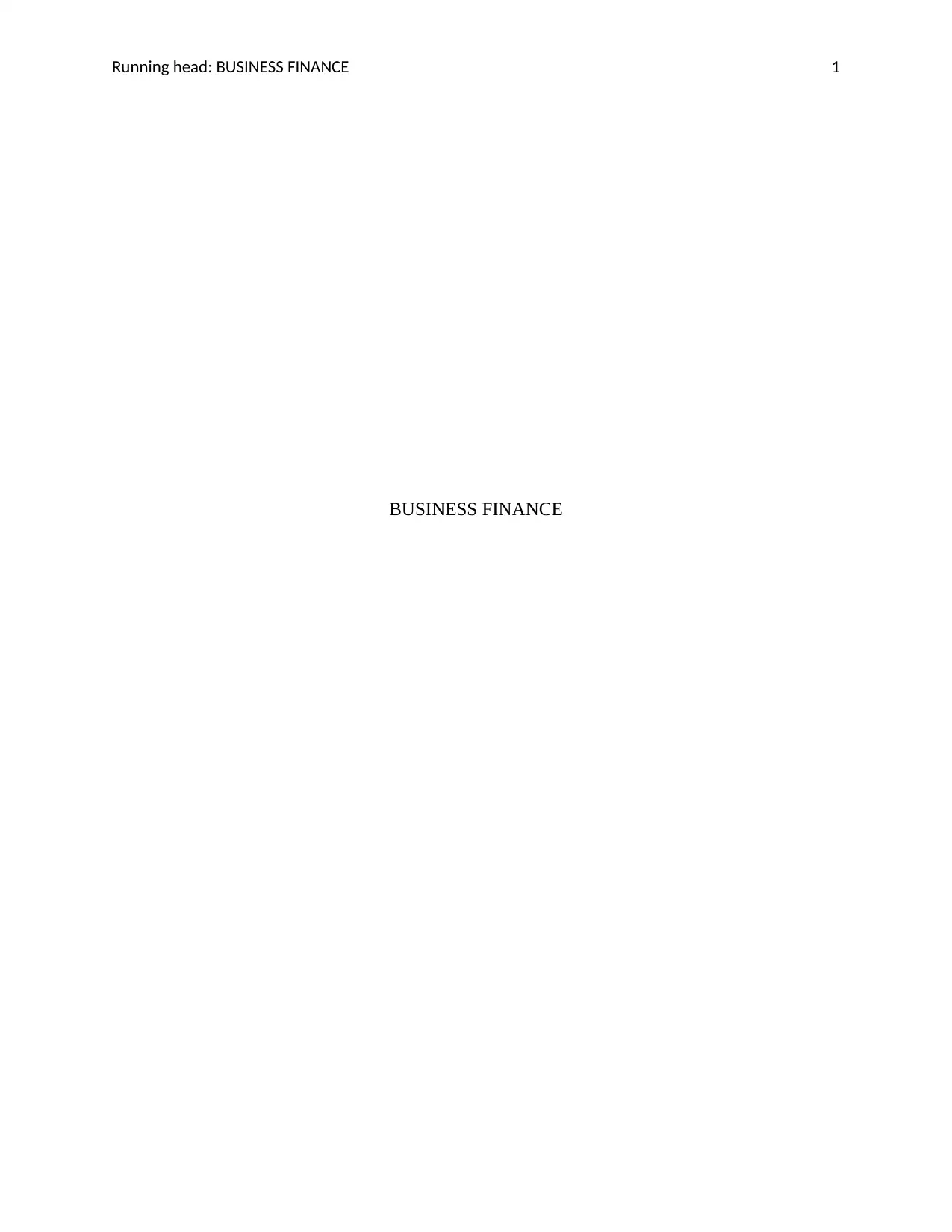
Running head: BUSINESS FINANCE 1
BUSINESS FINANCE
BUSINESS FINANCE
Paraphrase This Document
Need a fresh take? Get an instant paraphrase of this document with our AI Paraphraser
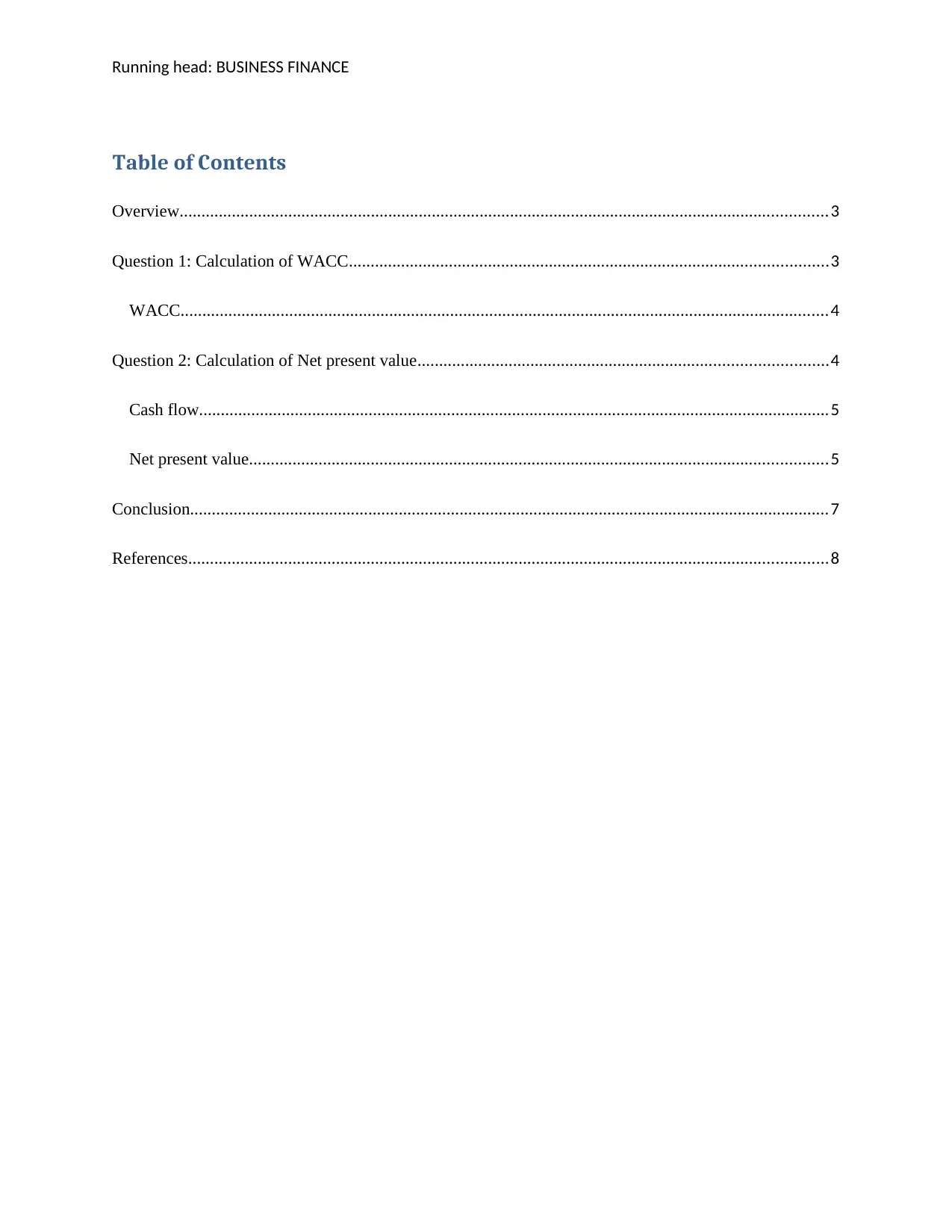
Running head: BUSINESS FINANCE
Table of Contents
Overview.....................................................................................................................................................3
Question 1: Calculation of WACC..............................................................................................................3
WACC.....................................................................................................................................................4
Question 2: Calculation of Net present value..............................................................................................4
Cash flow.................................................................................................................................................5
Net present value.....................................................................................................................................5
Conclusion...................................................................................................................................................7
References...................................................................................................................................................8
Table of Contents
Overview.....................................................................................................................................................3
Question 1: Calculation of WACC..............................................................................................................3
WACC.....................................................................................................................................................4
Question 2: Calculation of Net present value..............................................................................................4
Cash flow.................................................................................................................................................5
Net present value.....................................................................................................................................5
Conclusion...................................................................................................................................................7
References...................................................................................................................................................8
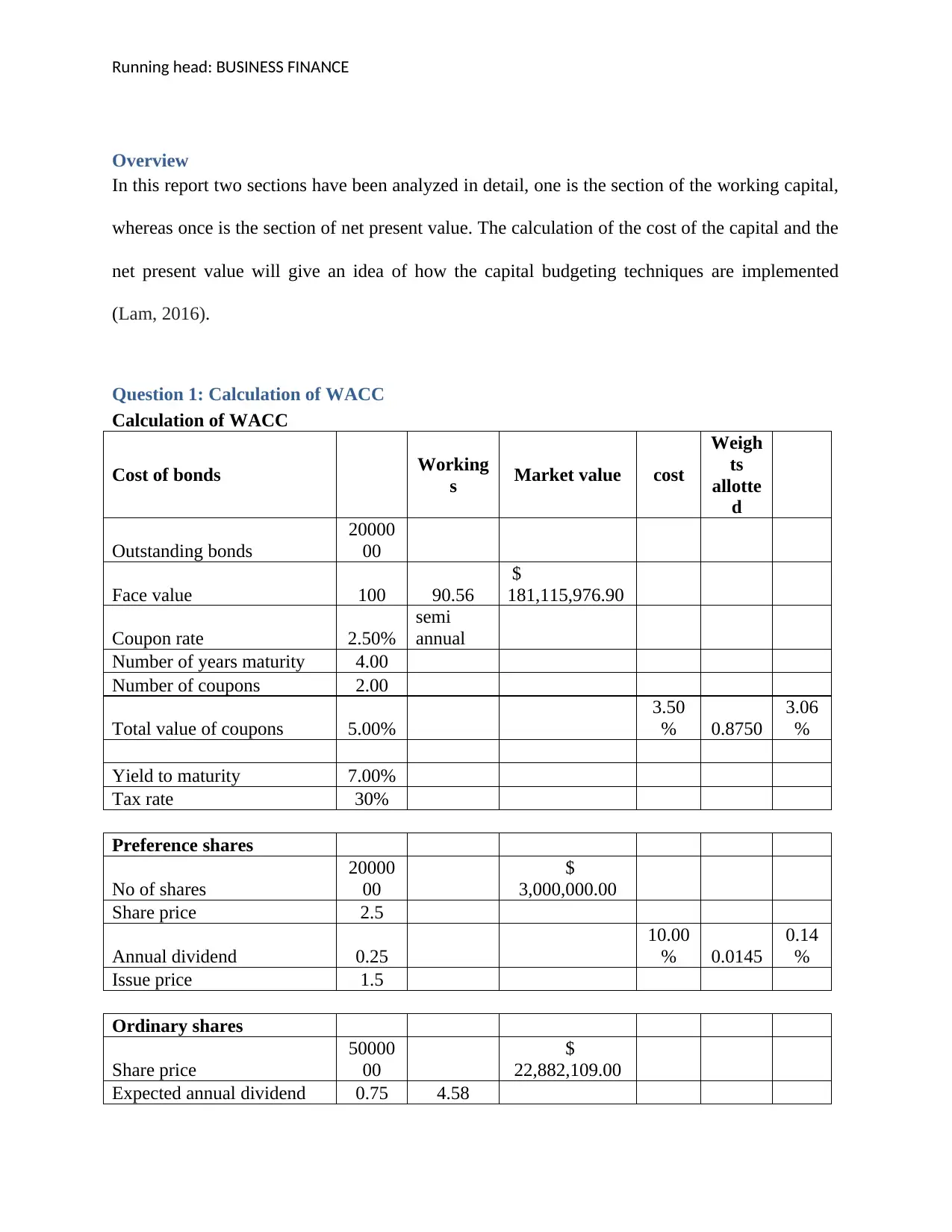
Running head: BUSINESS FINANCE
Overview
In this report two sections have been analyzed in detail, one is the section of the working capital,
whereas once is the section of net present value. The calculation of the cost of the capital and the
net present value will give an idea of how the capital budgeting techniques are implemented
(Lam, 2016).
Question 1: Calculation of WACC
Calculation of WACC
Cost of bonds Working
s Market value cost
Weigh
ts
allotte
d
Outstanding bonds
20000
00
Face value 100 90.56
$
181,115,976.90
Coupon rate 2.50%
semi
annual
Number of years maturity 4.00
Number of coupons 2.00
Total value of coupons 5.00%
3.50
% 0.8750
3.06
%
Yield to maturity 7.00%
Tax rate 30%
Preference shares
No of shares
20000
00
$
3,000,000.00
Share price 2.5
Annual dividend 0.25
10.00
% 0.0145
0.14
%
Issue price 1.5
Ordinary shares
Share price
50000
00
$
22,882,109.00
Expected annual dividend 0.75 4.58
Overview
In this report two sections have been analyzed in detail, one is the section of the working capital,
whereas once is the section of net present value. The calculation of the cost of the capital and the
net present value will give an idea of how the capital budgeting techniques are implemented
(Lam, 2016).
Question 1: Calculation of WACC
Calculation of WACC
Cost of bonds Working
s Market value cost
Weigh
ts
allotte
d
Outstanding bonds
20000
00
Face value 100 90.56
$
181,115,976.90
Coupon rate 2.50%
semi
annual
Number of years maturity 4.00
Number of coupons 2.00
Total value of coupons 5.00%
3.50
% 0.8750
3.06
%
Yield to maturity 7.00%
Tax rate 30%
Preference shares
No of shares
20000
00
$
3,000,000.00
Share price 2.5
Annual dividend 0.25
10.00
% 0.0145
0.14
%
Issue price 1.5
Ordinary shares
Share price
50000
00
$
22,882,109.00
Expected annual dividend 0.75 4.58
⊘ This is a preview!⊘
Do you want full access?
Subscribe today to unlock all pages.

Trusted by 1+ million students worldwide
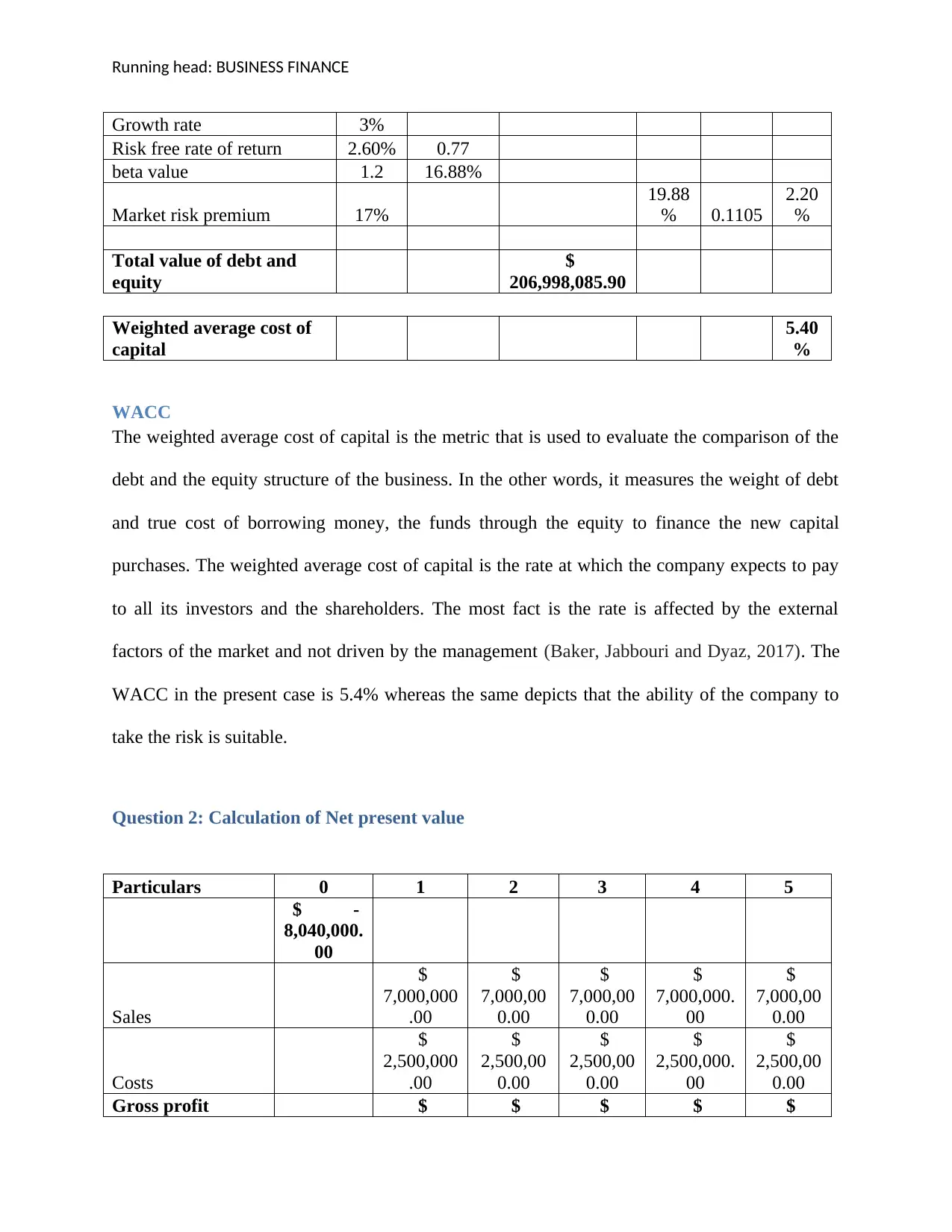
Running head: BUSINESS FINANCE
Growth rate 3%
Risk free rate of return 2.60% 0.77
beta value 1.2 16.88%
Market risk premium 17%
19.88
% 0.1105
2.20
%
Total value of debt and
equity
$
206,998,085.90
Weighted average cost of
capital
5.40
%
WACC
The weighted average cost of capital is the metric that is used to evaluate the comparison of the
debt and the equity structure of the business. In the other words, it measures the weight of debt
and true cost of borrowing money, the funds through the equity to finance the new capital
purchases. The weighted average cost of capital is the rate at which the company expects to pay
to all its investors and the shareholders. The most fact is the rate is affected by the external
factors of the market and not driven by the management (Baker, Jabbouri and Dyaz, 2017). The
WACC in the present case is 5.4% whereas the same depicts that the ability of the company to
take the risk is suitable.
Question 2: Calculation of Net present value
Particulars 0 1 2 3 4 5
$ -
8,040,000.
00
Sales
$
7,000,000
.00
$
7,000,00
0.00
$
7,000,00
0.00
$
7,000,000.
00
$
7,000,00
0.00
Costs
$
2,500,000
.00
$
2,500,00
0.00
$
2,500,00
0.00
$
2,500,000.
00
$
2,500,00
0.00
Gross profit $ $ $ $ $
Growth rate 3%
Risk free rate of return 2.60% 0.77
beta value 1.2 16.88%
Market risk premium 17%
19.88
% 0.1105
2.20
%
Total value of debt and
equity
$
206,998,085.90
Weighted average cost of
capital
5.40
%
WACC
The weighted average cost of capital is the metric that is used to evaluate the comparison of the
debt and the equity structure of the business. In the other words, it measures the weight of debt
and true cost of borrowing money, the funds through the equity to finance the new capital
purchases. The weighted average cost of capital is the rate at which the company expects to pay
to all its investors and the shareholders. The most fact is the rate is affected by the external
factors of the market and not driven by the management (Baker, Jabbouri and Dyaz, 2017). The
WACC in the present case is 5.4% whereas the same depicts that the ability of the company to
take the risk is suitable.
Question 2: Calculation of Net present value
Particulars 0 1 2 3 4 5
$ -
8,040,000.
00
Sales
$
7,000,000
.00
$
7,000,00
0.00
$
7,000,00
0.00
$
7,000,000.
00
$
7,000,00
0.00
Costs
$
2,500,000
.00
$
2,500,00
0.00
$
2,500,00
0.00
$
2,500,000.
00
$
2,500,00
0.00
Gross profit $ $ $ $ $
Paraphrase This Document
Need a fresh take? Get an instant paraphrase of this document with our AI Paraphraser
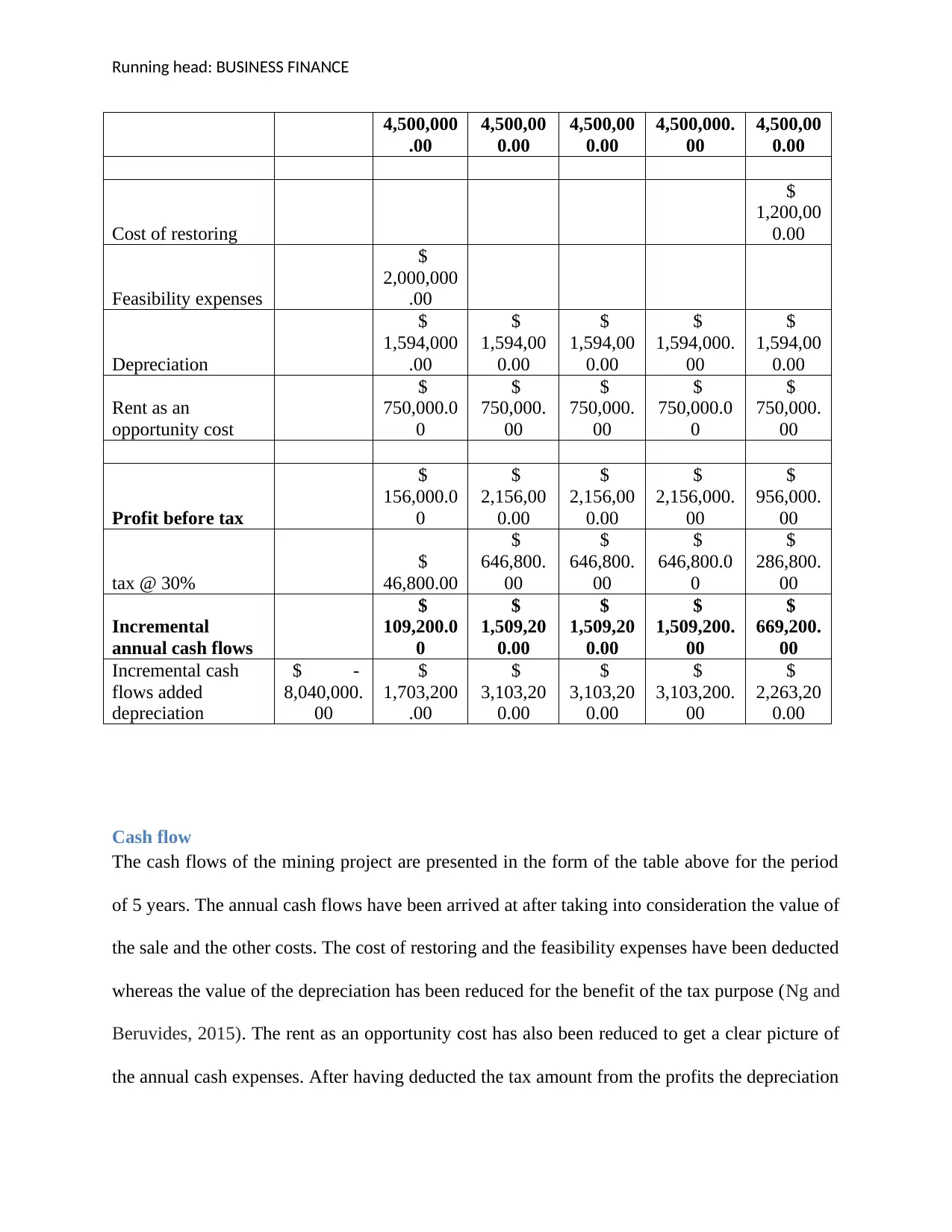
Running head: BUSINESS FINANCE
4,500,000
.00
4,500,00
0.00
4,500,00
0.00
4,500,000.
00
4,500,00
0.00
Cost of restoring
$
1,200,00
0.00
Feasibility expenses
$
2,000,000
.00
Depreciation
$
1,594,000
.00
$
1,594,00
0.00
$
1,594,00
0.00
$
1,594,000.
00
$
1,594,00
0.00
Rent as an
opportunity cost
$
750,000.0
0
$
750,000.
00
$
750,000.
00
$
750,000.0
0
$
750,000.
00
Profit before tax
$
156,000.0
0
$
2,156,00
0.00
$
2,156,00
0.00
$
2,156,000.
00
$
956,000.
00
tax @ 30%
$
46,800.00
$
646,800.
00
$
646,800.
00
$
646,800.0
0
$
286,800.
00
Incremental
annual cash flows
$
109,200.0
0
$
1,509,20
0.00
$
1,509,20
0.00
$
1,509,200.
00
$
669,200.
00
Incremental cash
flows added
depreciation
$ -
8,040,000.
00
$
1,703,200
.00
$
3,103,20
0.00
$
3,103,20
0.00
$
3,103,200.
00
$
2,263,20
0.00
Cash flow
The cash flows of the mining project are presented in the form of the table above for the period
of 5 years. The annual cash flows have been arrived at after taking into consideration the value of
the sale and the other costs. The cost of restoring and the feasibility expenses have been deducted
whereas the value of the depreciation has been reduced for the benefit of the tax purpose (Ng and
Beruvides, 2015). The rent as an opportunity cost has also been reduced to get a clear picture of
the annual cash expenses. After having deducted the tax amount from the profits the depreciation
4,500,000
.00
4,500,00
0.00
4,500,00
0.00
4,500,000.
00
4,500,00
0.00
Cost of restoring
$
1,200,00
0.00
Feasibility expenses
$
2,000,000
.00
Depreciation
$
1,594,000
.00
$
1,594,00
0.00
$
1,594,00
0.00
$
1,594,000.
00
$
1,594,00
0.00
Rent as an
opportunity cost
$
750,000.0
0
$
750,000.
00
$
750,000.
00
$
750,000.0
0
$
750,000.
00
Profit before tax
$
156,000.0
0
$
2,156,00
0.00
$
2,156,00
0.00
$
2,156,000.
00
$
956,000.
00
tax @ 30%
$
46,800.00
$
646,800.
00
$
646,800.
00
$
646,800.0
0
$
286,800.
00
Incremental
annual cash flows
$
109,200.0
0
$
1,509,20
0.00
$
1,509,20
0.00
$
1,509,200.
00
$
669,200.
00
Incremental cash
flows added
depreciation
$ -
8,040,000.
00
$
1,703,200
.00
$
3,103,20
0.00
$
3,103,20
0.00
$
3,103,200.
00
$
2,263,20
0.00
Cash flow
The cash flows of the mining project are presented in the form of the table above for the period
of 5 years. The annual cash flows have been arrived at after taking into consideration the value of
the sale and the other costs. The cost of restoring and the feasibility expenses have been deducted
whereas the value of the depreciation has been reduced for the benefit of the tax purpose (Ng and
Beruvides, 2015). The rent as an opportunity cost has also been reduced to get a clear picture of
the annual cash expenses. After having deducted the tax amount from the profits the depreciation
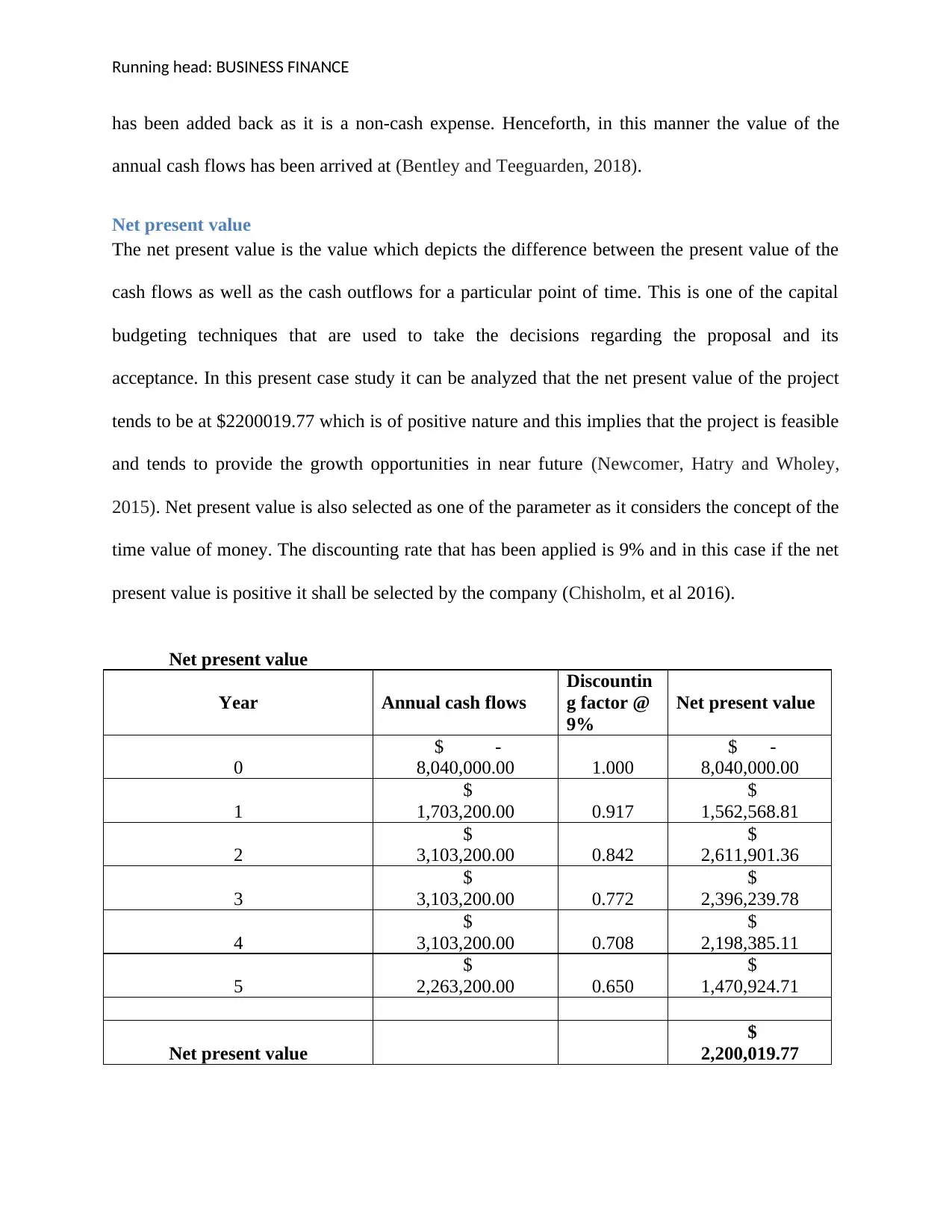
Running head: BUSINESS FINANCE
has been added back as it is a non-cash expense. Henceforth, in this manner the value of the
annual cash flows has been arrived at (Bentley and Teeguarden, 2018).
Net present value
The net present value is the value which depicts the difference between the present value of the
cash flows as well as the cash outflows for a particular point of time. This is one of the capital
budgeting techniques that are used to take the decisions regarding the proposal and its
acceptance. In this present case study it can be analyzed that the net present value of the project
tends to be at $2200019.77 which is of positive nature and this implies that the project is feasible
and tends to provide the growth opportunities in near future (Newcomer, Hatry and Wholey,
2015). Net present value is also selected as one of the parameter as it considers the concept of the
time value of money. The discounting rate that has been applied is 9% and in this case if the net
present value is positive it shall be selected by the company (Chisholm, et al 2016).
Net present value
Year Annual cash flows
Discountin
g factor @
9%
Net present value
0
$ -
8,040,000.00 1.000
$ -
8,040,000.00
1
$
1,703,200.00 0.917
$
1,562,568.81
2
$
3,103,200.00 0.842
$
2,611,901.36
3
$
3,103,200.00 0.772
$
2,396,239.78
4
$
3,103,200.00 0.708
$
2,198,385.11
5
$
2,263,200.00 0.650
$
1,470,924.71
Net present value
$
2,200,019.77
has been added back as it is a non-cash expense. Henceforth, in this manner the value of the
annual cash flows has been arrived at (Bentley and Teeguarden, 2018).
Net present value
The net present value is the value which depicts the difference between the present value of the
cash flows as well as the cash outflows for a particular point of time. This is one of the capital
budgeting techniques that are used to take the decisions regarding the proposal and its
acceptance. In this present case study it can be analyzed that the net present value of the project
tends to be at $2200019.77 which is of positive nature and this implies that the project is feasible
and tends to provide the growth opportunities in near future (Newcomer, Hatry and Wholey,
2015). Net present value is also selected as one of the parameter as it considers the concept of the
time value of money. The discounting rate that has been applied is 9% and in this case if the net
present value is positive it shall be selected by the company (Chisholm, et al 2016).
Net present value
Year Annual cash flows
Discountin
g factor @
9%
Net present value
0
$ -
8,040,000.00 1.000
$ -
8,040,000.00
1
$
1,703,200.00 0.917
$
1,562,568.81
2
$
3,103,200.00 0.842
$
2,611,901.36
3
$
3,103,200.00 0.772
$
2,396,239.78
4
$
3,103,200.00 0.708
$
2,198,385.11
5
$
2,263,200.00 0.650
$
1,470,924.71
Net present value
$
2,200,019.77
⊘ This is a preview!⊘
Do you want full access?
Subscribe today to unlock all pages.

Trusted by 1+ million students worldwide
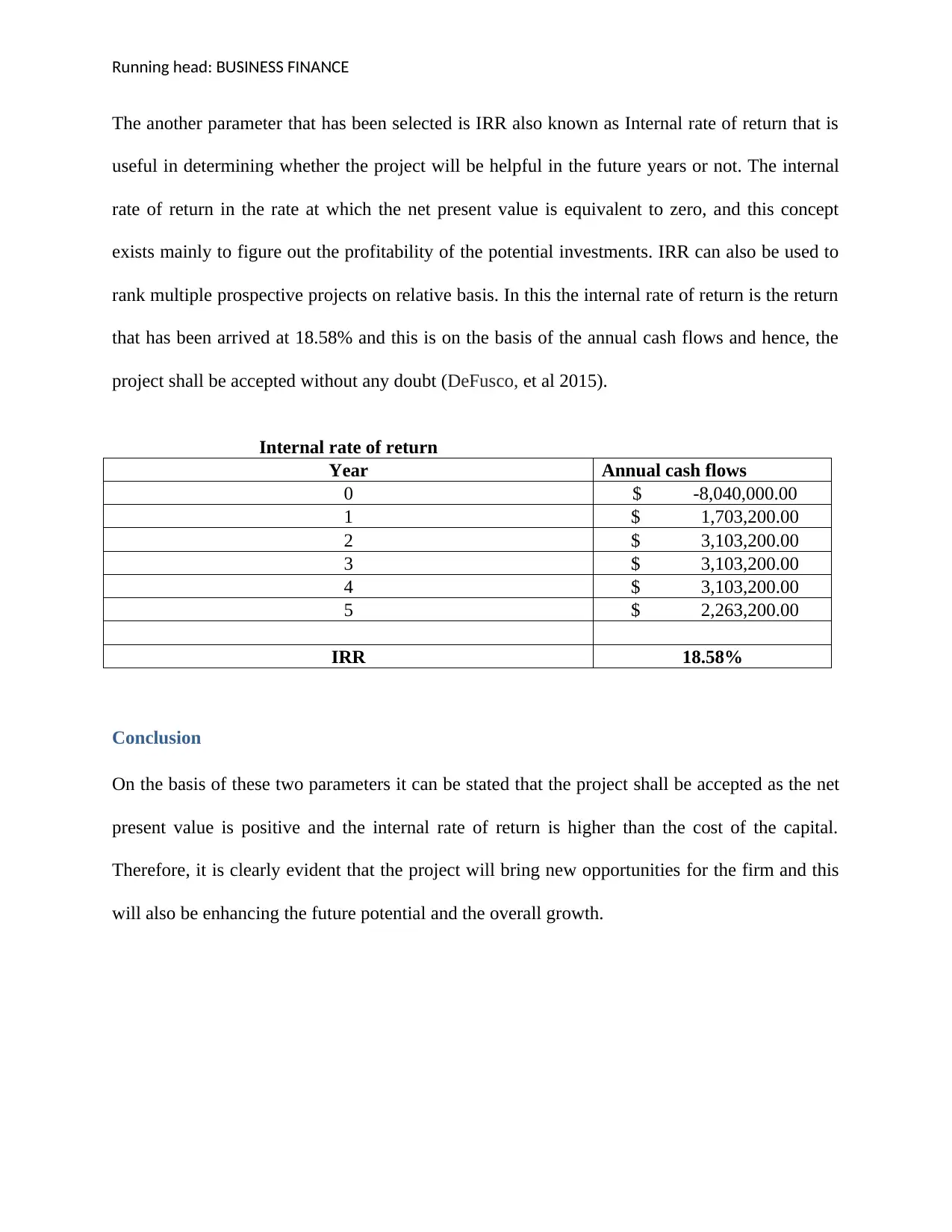
Running head: BUSINESS FINANCE
The another parameter that has been selected is IRR also known as Internal rate of return that is
useful in determining whether the project will be helpful in the future years or not. The internal
rate of return in the rate at which the net present value is equivalent to zero, and this concept
exists mainly to figure out the profitability of the potential investments. IRR can also be used to
rank multiple prospective projects on relative basis. In this the internal rate of return is the return
that has been arrived at 18.58% and this is on the basis of the annual cash flows and hence, the
project shall be accepted without any doubt (DeFusco, et al 2015).
Internal rate of return
Year Annual cash flows
0 $ -8,040,000.00
1 $ 1,703,200.00
2 $ 3,103,200.00
3 $ 3,103,200.00
4 $ 3,103,200.00
5 $ 2,263,200.00
IRR 18.58%
Conclusion
On the basis of these two parameters it can be stated that the project shall be accepted as the net
present value is positive and the internal rate of return is higher than the cost of the capital.
Therefore, it is clearly evident that the project will bring new opportunities for the firm and this
will also be enhancing the future potential and the overall growth.
The another parameter that has been selected is IRR also known as Internal rate of return that is
useful in determining whether the project will be helpful in the future years or not. The internal
rate of return in the rate at which the net present value is equivalent to zero, and this concept
exists mainly to figure out the profitability of the potential investments. IRR can also be used to
rank multiple prospective projects on relative basis. In this the internal rate of return is the return
that has been arrived at 18.58% and this is on the basis of the annual cash flows and hence, the
project shall be accepted without any doubt (DeFusco, et al 2015).
Internal rate of return
Year Annual cash flows
0 $ -8,040,000.00
1 $ 1,703,200.00
2 $ 3,103,200.00
3 $ 3,103,200.00
4 $ 3,103,200.00
5 $ 2,263,200.00
IRR 18.58%
Conclusion
On the basis of these two parameters it can be stated that the project shall be accepted as the net
present value is positive and the internal rate of return is higher than the cost of the capital.
Therefore, it is clearly evident that the project will bring new opportunities for the firm and this
will also be enhancing the future potential and the overall growth.
Paraphrase This Document
Need a fresh take? Get an instant paraphrase of this document with our AI Paraphraser

Running head: BUSINESS FINANCE
References
Baker, H.K., Jabbouri, I. and Dyaz, C., 2017. Corporate finance practices in
Morocco. Managerial Finance, 43(8), pp.865-880.
Bentley, W.R. and Teeguarden, D.E., 2018. Financial maturity: a theoretical review.
In Economics of Forestry (pp. 67-78). Routledge.
Chisholm, D., Sweeny, K., Sheehan, P., Rasmussen, B., Smit, F., Cuijpers, P. and Saxena, S.,
2016. Scaling-up treatment of depression and anxiety: a global return on investment
analysis. The Lancet Psychiatry, 3(5), pp.415-424.
DeFusco, R.A., McLeavey, D.W., Pinto, J.E., Runkle, D.E. and Anson, M.J., 2015. Quantitative
investment analysis. John Wiley & Sons.
Lam, A.P., 2016. Finance-Economic Analysis and Evaluation of Oil and Gas Industry: A Case
Study of X Oil Field in Nam Con Son Basin (Doctoral dissertation).
Newcomer, K.E., Hatry, H.P. and Wholey, J.S., 2015. Cost-effectiveness and cost-benefit
analysis. Handbook of practical program evaluation, p.636.
Ng, E.H. and Beruvides, M.G., 2015. Multiple internal rate of return revisited: frequency of
occurrences. The Engineering Economist, 60(1), pp.75-87.
References
Baker, H.K., Jabbouri, I. and Dyaz, C., 2017. Corporate finance practices in
Morocco. Managerial Finance, 43(8), pp.865-880.
Bentley, W.R. and Teeguarden, D.E., 2018. Financial maturity: a theoretical review.
In Economics of Forestry (pp. 67-78). Routledge.
Chisholm, D., Sweeny, K., Sheehan, P., Rasmussen, B., Smit, F., Cuijpers, P. and Saxena, S.,
2016. Scaling-up treatment of depression and anxiety: a global return on investment
analysis. The Lancet Psychiatry, 3(5), pp.415-424.
DeFusco, R.A., McLeavey, D.W., Pinto, J.E., Runkle, D.E. and Anson, M.J., 2015. Quantitative
investment analysis. John Wiley & Sons.
Lam, A.P., 2016. Finance-Economic Analysis and Evaluation of Oil and Gas Industry: A Case
Study of X Oil Field in Nam Con Son Basin (Doctoral dissertation).
Newcomer, K.E., Hatry, H.P. and Wholey, J.S., 2015. Cost-effectiveness and cost-benefit
analysis. Handbook of practical program evaluation, p.636.
Ng, E.H. and Beruvides, M.G., 2015. Multiple internal rate of return revisited: frequency of
occurrences. The Engineering Economist, 60(1), pp.75-87.
1 out of 8
Related Documents
Your All-in-One AI-Powered Toolkit for Academic Success.
+13062052269
info@desklib.com
Available 24*7 on WhatsApp / Email
![[object Object]](/_next/static/media/star-bottom.7253800d.svg)
Unlock your academic potential
Copyright © 2020–2026 A2Z Services. All Rights Reserved. Developed and managed by ZUCOL.




